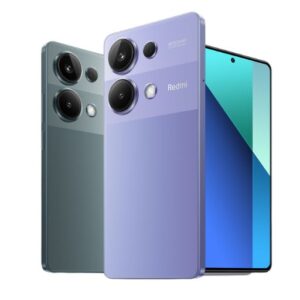Xiaomi Redmi Note 13 Pro vs Redmi Note 13 Pro Plus: A Detailed Comparison
In the ever-evolving landscape of smartphone technology, Xiaomi continues to push boundaries with its Redmi Note series. Among the latest offerings, the Xiaomi Redmi Note 13 Pro and Redmi Note 13 Pro Plus stand out as feature-packed mid-range contenders. While these two devices share many similarities, there are nuanced differences that could influence your purchasing decision. In this article, we’ll dissect the key distinctions between the Redmi Note 13 Pro and its higher-end counterpart, the Redmi Note 13 Pro Plus. From design aesthetics to performance capabilities, we’ll explore how these smartphones stack up against each other, helping you determine which one suits your preferences and requirements.
Features |
Redmi Note 13 Pro | Redmi Note 13 Pro Plus |
|---|---|---|
| Design | Flat design, plastic frame | Curved design, aluminum frame; option for vegan leather back |
| Ingress Protection | IP54 | IP68 |
| Display | 6.67-inch 120Hz OLED panel with flat glass | 6.67-inch 120Hz OLED panel with curved glass edges |
| Audio | Stereo speakers with slightly less balanced sound | Stereo speakers with fuller sound; lacks 3.5mm audio jack |
| Software | MIUI on top of Android 14 | MIUI on top of Android 14 |
| Chipset | Qualcomm Snapdragon 7s Gen 2 | MediaTek Dimensity 7200 |
| Storage | 128GB UFS 2.2 | 256GB UFS 3.1 |
| Battery Life | Similarly, around 10-11 hours of active use | Similarly, around 10-11 hours of active use |
| Charging Speed | 67W fast charging, full charge in 42 minutes | 120W fast charging, full charge in 25 minutes |
| Cameras | 200MP main, 8MP ultra-wide, 2MP macro, 16MP front | 200MP main, 8MP ultra-wide, 2MP macro, 16MP front |
| Camera Performance | Similar photo quality; Pro Plus tends to produce brighter images, Pro has more natural and contrasty look | Similar photo quality; Pro Plus tends to produce brighter images, Pro has more natural and contrasty look |
| Video Performance | Video quality slightly sharper and more detailed on the Pro model | Video quality slightly sharper and more detailed on the Pro model |
Redmi Note 13 Pro
|
 |
Redmi Note 13 Pro Plus
|
 |
Review
The Xiaomi Redmi Note 13 Pro and Redmi Note 13 Pro Plus are two formidable contenders in the mid-range smartphone market, offering a plethora of features and capabilities. Let’s delve into a detailed review of these devices to understand their strengths and weaknesses.
Design:
Both the Redmi Note 13 Pro and Pro Plus boast sleek designs that exude modernity and sophistication. The Pro Plus takes a step further with its curved design and premium aluminum frame, providing a more ergonomic feel in hand. Additionally, the option for a vegan leather back adds a touch of luxury to the Pro Plus variant. On the other hand, the Redmi Note 13 Pro sports a flat design with a plastic frame, which may not feel as premium but still offers durability.
Display:
Equipped with vibrant 6.67-inch OLED panels and a smooth 120Hz refresh rate, both devices deliver stunning visuals and seamless scrolling experiences. While the Pro Plus edges ahead with its curved glass edges, enhancing aesthetics, the difference in display quality between the two models is negligible. Whether you opt for the Pro or Pro Plus, you can expect sharp images, excellent brightness, and support for Dolby Vision and HDR10+ video playback.
Performance:
Under the hood, the Redmi Note 13 Pro houses the Qualcomm Snapdragon 7s Gen 2 chipset, while the Pro Plus boasts the MediaTek Dimensity 7200. Both chipsets offer commendable performance, ensuring smooth multitasking and lag-free usage. However, the Pro Plus shines in graphics-intensive tasks, thanks to its superior GPU performance. Whether you’re gaming or tackling productivity tasks, both devices handle the job with aplomb.
Storage and Battery:
In terms of storage, the Pro Plus takes the lead with its generous 256GB of UFS 3.1 storage, offering faster read and write speeds compared to the Pro’s 128GB of UFS 2.2 storage. When it comes to battery life, both devices offer similar endurance, lasting around 10-11 hours of active use. However, the Pro Plus gains an advantage with its blazing-fast 120W charging capability, allowing for a full charge in just 25 minutes, compared to the Pro’s 67W fast charging.
Camera Performance:
Both the Redmi Note 13 Pro and Pro Plus feature a versatile quad-camera setup, including a 200MP main camera, an 8MP ultra-wide lens, a 2MP macro camera, and a 16MP front-facing camera. While the camera hardware remains identical, subtle differences in image processing result in nuanced differences in photo output. The Pro Plus tends to produce brighter and more vibrant images, while the Pro delivers a more natural and contrasty look. However, both devices excel in capturing detailed and well-balanced shots in various lighting conditions.
Which Are Best For Users Xiaomi Redmi Note 13 Pro vs Redmi Note 13 Pro Plus
Determining which device is best for a user depends on their specific needs, preferences, and budget. Here’s a breakdown to help users make an informed decision:
Choose the Redmi Note 13 Pro if
|
Choose the Redmi Note 13 Pro Plus if
|
Ultimately, both the Redmi Note 13 Pro and Redmi Note 13 Pro Plus offer impressive features and value for money. Users should carefully consider their priorities and budget to determine which device aligns best with their needs and preferences.
In summary, the Xiaomi Redmi Note 13 Pro is a great choice for users prioritizing affordability, headphone jack availability, balanced sound, and durability. On the other hand, the Redmi Note 13 Pro Plus excels with its premium design, faster charging, ample storage, and superior gaming performance. Users should assess their priorities to select the device that best suits their needs and budget.
